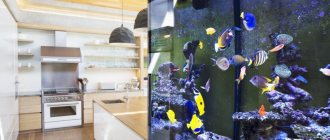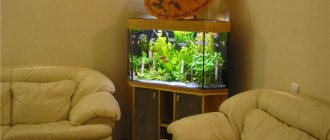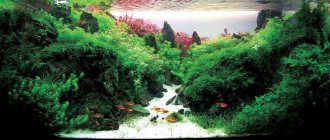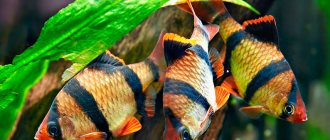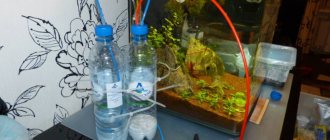Shapes and types of aquariums
There are many types of aquariums. First of all, aquariums are divided into decorative and special (auxiliary), depending on what they are intended for. The shape and size of the aquarium vary greatly and depend on the purpose of their use.
Special aquariums most often have a rectangular shape, they are small and low. The water level in them usually does not exceed 30-35 cm. This is quite enough for fry, juveniles, and a couple of fish.
The shape of decorative aquariums is more varied: there are spherical, cylindrical, hexagonal, triangular and traditional rectangular aquariums. There are also wall-mounted aquariums with a slanted front glass and triangular side faces, called picture aquariums, as well as panoramic aquariums with curved glass.
Such a variety of forms became possible relatively recently, after the advent of new materials: plexiglass and acrylic. For a long time, aquariums were framed, that is, they necessarily had a metal frame on which glass surfaces were attached. Therefore, all edges of the aquarium could only be straight. One of the biggest disadvantages of these heavy and not very beautiful structures was that they retained their integrity only when wet. After draining the water, the joint putty quickly dried out, and the aquarium could leak.
Therefore, they have been replaced by frameless aquariums, which are now made of plexiglass, acrylic and individual glasses. Plexiglas aquariums can come in different shapes, but they are all small in size, since plexiglass does not have the strength of glass and cannot withstand high water pressure. Such aquariums are difficult to break, but easy to scratch. And under the influence of certain substances, organic glass can become cloudy. Acrylic is both durable and flexible at the same time; Large aquariums of various shapes are made from it. But the service life of an acrylic aquarium is still less than that of a glass one. Acrylic, like plexiglass, scratches easily.
Frameless glass aquariums can be neither cylindrical nor spherical. The connection of individual glasses to each other requires the presence of corners at the joints. Therefore, the shape options for such aquariums are limited to triangular, rectangular, and hexagonal shapes. But their sizes vary from small to very large. To make frameless aquariums, ground glass is used, and the joints are filled with a special glue that has exceptional strength. Glued aquariums do not dry out even when dry; glass is much easier to care for than its substitutes. And besides, it is much more beautiful and much more durable than plexiglass and acrylic. It is not difficult to maintain the transparency of glass - it is difficult to scratch, but it can be broken.
Aquarium shapes
The main forms of aquariums with their features, pros and cons are described below.
Standard aquarium
This type of aquarium is worth recommending to a novice hobbyist. It combines good proportions with ease of cleaning and other necessary procedures. The width of such a vessel is equal to the height, and the length is twice the width. Of course, these are approximate parameters that do not necessarily have to match down to the centimeter. An aquarium with such proportions is clearly visible, and the fish feel fine in it. It is advisable that the width does not exceed half a meter, otherwise due to the slightest cloudiness or poorly thought out planting, you will have trouble seeing your pets. Lighting fixtures in such aquariums should be located above the cover glass to prevent splashes. A standard aquarium can be used as a species or decorative one.
Panoramic aquarium
This is a stylish, modern aquarium. Thanks to the panoramic viewing glass, the viewing angle of the aquarium increases, allowing you to enjoy its underwater world from anywhere in the room, and also opens up new possibilities for using the aquarium for decorative purposes.
Corner aquariums
They look good in interiors of any style and trend and that is why they are so popular among designers today. Modern materials and technologies make it possible to produce corner aquariums of high quality and various geometries, which allows the aquarium to be best positioned in the corner of the room. Most often, corner aquariums come in trapezoidal and hemispherical shapes.
A well-designed corner aquarium creates a visual effect of large volume, extensive space, depth, and mystery. Thus, in combination with various design and decoration techniques, wisely selecting aquatic plants, fish, soil, you can very beautifully and originally “furnish” the corners of the room, the space of which is most often unoccupied. Corner aquariums provide a wonderful opportunity to rationally manage space and at the same time have a fashionable, useful and original piece of furniture that is pleasing to the eye, giving a lot of positive emotions, harmony, rest, and relaxation.
Aquarium Koryto
This is a “flattened” version of the standard aquarium. Its parameters: width is equal to half the length, height is one third of the length. In such vessels it is easy to achieve the required lighting conditions and gas balance. Due to the fact that the water is well saturated with oxygen, the aquarium can be densely populated even with a small volume. This makes it indispensable in small and crowded apartments. In a “trough” aquarium you can raise young fish or use it as a species and decorative one.
Aquarium Screen
The width is one third of the length, and the height is half the length. The main advantage of such aquariums is that the fish in them will always be in your sight, and this enhances the decorative effect. It is good to keep large and tall plants and fish like angelfish in them. Water turbidity does not affect visibility. But such aquariums are poor in oxygen in the lower part, due to the fact that the surface area of the water is relatively small. If you do not use strong enough aeration, the fish will feel uncomfortable in it.
Fishbowl
Once upon a time, aquariums of this shape were widespread among hobbyists. Now we can say without exaggeration that “is the round aquarium outdated?” Due to the curvature of the glass, the appearance of the fish and the entire design of the artificial reservoir are distorted. In addition, dirt settles not only on the bottom, but also on the walls of the aquarium.
Cylindrical or polyhedral aquarium
Despite the decorative nature, the fish and other inhabitants will look unnatural due to the deformed walls. Such aquariums look attractive only if they are placed so that they can be admired from all sides. If you like an aquarium of this shape, think in advance whether you can position it properly.
Which aquarium shape is best? Preference should still be given to a rectangular aquarium, since it does not distort the picture of the underwater world, as happens in spherical and cylindrical aquariums, where both fish and plants look unnatural.
Aquarium painting
This is just an example when the designer had a large hand in creating an aquarium. After all, it is difficult to ensure a comfortable existence for the inhabitants of such an aquarium, and caring for it is problematic due to its size, and also because of its location, since it hangs on the wall.
Built-in aquariums
Widely used in both public and private interiors. This very effective design technique can give any room a special chic and uniqueness. Built-in aquariums are best planned during renovation or reconstruction of the premises. What options are there for the location of a built-in aquarium?
• Built-in aquariums in the form of a screen. Such an aquarium looks very impressive when zoning a room. For example, a screen with a built-in aquarium can be used to separate a relaxation area with a group of upholstered furniture. In this case, the screen with the aquarium serves not only as a partition, but also as a “living picture” of the underwater kingdom. • Built-in aquariums located in the through wall opening. In this version, the aquarium “works” for two adjacent rooms, which is already good. At the same time, the type of design of the aquarium on each side can be different, which allows you to “fit” the aquarium into any interior styles of the rooms. For example, on one side the aquarium can be designed in the form of a baguette frame, and on the other side an arc panoramic glass can be made. • Built-in aquariums located in a niche. As a rule, in this embodiment, the aquarium is located at eye level of a sitting person. This location is convenient for relaxation, when you can comfortably contemplate the wonderful seascape from a cozy armchair or sofa. • Built-in aquariums located in the arch. This is a very successful design find in the case when you need to partially isolate part of the room using a screen. A marine-themed glass screen will decorate any space.
The most affordable are aquariums produced in the form of a separate container. But such an aquarium must also be equipped with the appropriate equipment: filters, an aerator, a thermostat and lighting fixtures. Therefore, when purchasing an inexpensive aquarium tank, think about the price of the equipment. If you have skillful hands, then, of course, you can make some devices yourself, but in any case you will need materials, as well as equipment. Such aquariums are usually installed on a separate stand.
There are special stands on which you can place several aquariums at once, one above the other, strictly vertically or on ledges.
Aquariums made in the form of a piece of furniture are much more expensive, but they are often equipped with all the necessary equipment, so there is less hassle with placing and connecting such an aquarium. Some varieties of such aquariums require a special stand that can withstand enormous weight; others are sold already with the stand and form a single whole with it. If such aquariums are not equipped with equipment, then they have a special compartment where all the necessary equipment can not only be easily placed, but also hidden from the view of the observer, so as not to spoil the impression of the overall appearance of the aquarium.
Video
Aquarium. Tips for beginners. Fish Keeping Basics
ABC of #aquariums. All about the #aquarium and its #contents.
What you need to know to start an aquarium. Part 1
Which aquarium is better? All about choosing an aquarium
Types of aquariums (by habitat)
Based on their habitat, all aquariums can be divided into several categories: freshwater, marine, and brackish.
Freshwater aquariums
Freshwater aquarium - pseudo-sea
They contain freshwater fish and plants. Most aquarists prefer this type of aquarium.
Marine aquariums
Designed for keeping marine fish and plants. As a rule, a marine aquarium is large in size (from 400 l). This is due to the fact that its inhabitants are usually larger than the inhabitants of freshwater aquariums. When selecting fish for a marine aquarium, it is necessary to take into account that species that are similar in size, similar in behavior and living conditions get along better.
It is preferable to populate the aquarium with species that live at different levels. Population of a marine aquarium is carried out at the rate of 1 cm of fish length per 5-8 liters of water. Compared to others, a marine aquarium is the most labor-intensive to operate, since maintaining marine organisms requires maintaining conditions that are much higher than those of freshwater aquariums. Increased attention to the condition of the water (density, acidity, water temperature, etc.) is required. A reef saltwater aquarium is especially difficult to maintain. These aquariums are the most expensive and difficult to operate. Caring for a marine aquarium requires special knowledge, skills and experience.
Brackish water aquarium
There are some species of animals and plants that live in a special environment (water salinity does not exceed 1-2%) that is not often found in nature. These are species such as trampweed, Cryptocoryne ciliata, and brackish-water-marine diatoms. Stingrays and many species of viviparous fish (for example, guppies, some mollies) are found not only in fresh but also in brackish waters.
Preparing the soil
The soil is an important part, because it allows you to create an organic microclimate, is a nutrient medium and does not allow places of stagnant water to appear. It is where 90 percent of beneficial bacteria live. Read more about choosing soil in a separate article.
Rinse the soil. If you choose pebbles or gravel, then you need to prepare salted water and boil them for 1 hour. If sand is used, heat it in a frying pan for 30 minutes, stirring constantly. After this, you need to sift the sand through a fine sieve to rid and remove small impurities. The soil is ready.
Now fill the aquarium 1/3 with water and lower the soil there. You can do this evenly over the entire bottom, you can make small slides and hillocks - it’s at your discretion. But the soil should fill the bottom by at least 4–5 cm.
Types of Aquariums
According to their functional purpose, aquariums are divided into decorative and special.
Decorative aquariums
Decorative ones are designed to solve aesthetic problems, create beauty, comfort, create aesthetic pleasure along with a thoughtful design, which includes plants, soil, other animals, etc.
Decorative aquariums include:
Community aquarium
A beginner's hobby, where many species of fish of different systematic groups and geographical zones peacefully coexist (rasboras, neons, colis, platies, needles, etc.). Contains many different species of fish, invertebrates and plants. Does not imply the maintenance of living organisms united by any one theme or geographical area.
Collection aquarium
It mainly includes certain groups of fish; it is home to the maximum number of representatives of one family (characids, cichlids, poecilids, etc.).
Species aquarium
A special case of a collection aquarium, it contains only one species or several related species of fish (elassomas, barbs, guppies, rainbowfish, etc.).
Aquarium biotope
A kind of copy of any part of the natural environment (the coastal zone of the Congo River, the rocky relief of Lake Nyasa, the coral littoral of the Red Sea, etc.).
Dutch aquarium
A harmonious combination in one container of species and varieties of aquatic plants varied in volume and color (fauna recedes into the background). The main design element of a “Dutch aquarium” is living plants. Most often, individual bushes are collected in dense groups, so that when viewed from above, only their tops are visible. Plants are planted in such a way that those located in the foreground do not cover those growing behind. Large bushes of plants such as Echinodorus, Anubias, some aponogetons or nymphs, often having a color different from the color of the rest of the plants, look good. The selected species should not produce floating or emergent leaves. Caring for a “Dutch aquarium” consists of periodically (20-25% per week and a half) changing the water, removing old dead leaves, and forming thickets of long-leaved plants.
The main thing in a “Dutch aquarium” is plants, but any small non-herbivorous fish such as neon, rasbora, zebrafish, algae-eating catfish, labeo, livebearers, and mollies can complete the picture.
Paludarium
A combination of underwater and above-water vegetation, a kind of aqua-greenhouse. The paludarium is a unique invention of animal lovers. The high humidity in the paludarium is ideal for the growth of marsh or tropical plants, as well as for many aquarium plants. For decoration, you can use driftwood, preferably those with moss overgrowth, and knotty acacia branches, on which many epiphytes and other plants grow especially well. Such “epiphytic trees” always look very attractive.
Aquaterrarium
Serves for simultaneous maintenance and display of combined aquarium and terrarium inhabitants. For keeping many amphibians and reptiles that lead a semi-aquatic lifestyle, the most suitable is an aqua-terrarium, which is made on the basis of an aquarium that holds water well, the land in which is represented by numerous islands. To create comfortable conditions for the inhabitants of an aqua-terrarium, soil, lighting and vegetation suitable for the biotope are of great importance.
Nano aquarium
This is a small container, its volume not exceeding 30-40 liters, and much more often two to three times less. Interest in nano-aquariums is now spreading more and more.
The now fashionable nano-aquarium is a miniature water tank with ornamental plants and fish. With a nano aquarium you can fulfill the dream of recreating a unique aquarium design seen in a store or somewhere online, but on a much smaller scale. This type of aquarium places fewer demands on technical equipment and maintenance, and it is also possible to install the aquarium on a desktop at home or in the office.
Special aquariums
According to their functional purpose, aquariums are divided into decorative and special.
Special aquariums are designed to solve specific problems: incubating eggs, raising young animals, breeding and treating fish, conducting various experiments. In accordance with their specifics, they are divided into:
Spawning aquariums
Needed for breeding fish in captivity. The size of the spawning tank, substrate, water composition, lighting and other conditions are selected individually. Maximum sterility must be maintained. For convenience, the spawning aquarium should be smaller than the main one. This will make it easier to find the swept eggs and remove the dead ones. Different fish species require spawning tanks with different proportions.
Incubators
Auxiliary containers necessary for life support of developing eggs and larvae of aquarium inhabitants. Their capacity ranges from 0.5 to 25 liters. A minimum volume is required for egg-laying carp-toothed fish that lay their eggs in peat; the maximum is for incubating discus eggs left by the parents. The main conditions for maintaining an incubator aquarium are: cleanliness, optimal temperature, hydrochemical composition and oxygen regime.
Quarantine and treatment aquariums
They are used to hold and adapt newly arriving animals, as well as to treat them. The main conditions: space, hygiene, minimum stress, constant monitoring of water quality. All its parameters (proportions, design, etc.) depend primarily on the size of the fish contained in it and the duration of their stay in the quarantine-medicinal aquarium. The same can be said about breeding aquariums.
Nursery aquariums
Trough-shaped vessels designed for quickly growing a large number of fry. The desired size is 150x45x60 cm. The main conditions for keeping fish: optimal environmental conditions (temperature, hardness, salinity of water, etc.), regular water changes and abundant varied feeding.
Cultivators
They ensure mass reproduction of food items that inhabit the water: ciliates, algae, crustaceans, rotifers, etc. The main conditions for their cultivation: the largest possible area, careful selection of the environment and nutrition.
Breeding
They contain fish necessary for breeding work.
Naturally, in one aquarium you can achieve various goals, for example, simultaneously keeping, treating and breeding fish.
Selim plants
After 5–7 days we can plant the plants. But to create a good microclimate, it is recommended to plant simple aquarium plants first: hornwort, nayas, vallisneria, anubias, elodea, Indian fern, riccia, hygrophila, ambulia. Any of these plants will cope perfectly with the formation of a biological environment.
Try to set the lighting to about 0.35 watt/l. Turn on the lights for 8 hours every day.
Choosing a location, checking and installing an aquarium
Before installation, it is advisable to check the aquarium for “fluidity”, because it is much easier to eliminate the leak before installing and populating the aquarium. It is especially important to check old aquariums that have been “inherited” to you. To do this, place a vessel filled with water on a newspaper and wait at least a day. If there is a leak, the newspaper will be wet and the aquarium will have to be repaired before installation.
Once you are sure that your aquarium is safe, rinse it with warm (about 50°C) water. You should not use detergents to clean your aquarium because they leave behind a harmful residue that can have a bad effect on your fish and plants.
Aquarium disinfection
It is advisable to disinfect, especially if the aquarium has already been used. A 2% solution of bleach or a 1% solution of copper sulfate is suitable. After disinfection, the aquarium should be thoroughly rinsed and wiped dry with a clean cloth.
A frameless aquarium is washed with warm water with the addition of salt or a 5% solution of acetic or hydrochloric acid. The frame aquarium is thoroughly washed with water at room temperature with baking soda or laundry soap. If the frame aquarium you purchased is made using putty, then you first need to remove excess putty from the frame, and then wash it.
It must be remembered that a frame aquarium should not be left without water for more than 2 days - it may leak. All actions to prepare the aquarium for settlement should be carried out as quickly as possible.
Aquarium installation
A stand is required on which you will install the aquarium. It should be a smooth, flat surface that can support the weight of the aquarium with water. Expensive stands are made in the form of a cabinet, which has compartments for storing aquarium accessories. A cheaper solution could be a shelving unit: either welded metal, or made from angles bolted together, or wooden.
You may already have a suitable surface in your home. If you have not purchased a special cabinet, you will need a sheet of plywood with sanded edges to fit the size of the bottom of the aquarium and at least 15 mm thick. In addition, a 13 mm thick polystyrene sheet should be placed under the aquarium; this will help distribute the load and level out uneven surfaces between the cabinet and the aquarium. There should also be an electrical outlet nearby to connect aquarium equipment. The aquarium should not be placed near a window or in a place exposed to direct sunlight. Sunlight causes unwanted heating of the water and encourages algae growth.
Filling the aquarium with water
The aquarium is first filled to half the capacity. And after a day, increase the water level in the aquarium so that 3-5 cm remains to the top edge. Thus, you achieve a gradual increase in pressure, which will avoid such troubles as broken glass. But this applies more to larger aquariums.
Let your aquarium remain filled with water for 24 hours. During this time you will discover if it is leaking. Then drain all the water from the aquarium. This is necessary for the final cleaning of the aquarium.
General recommendations
Beginner aquarists will find useful tips and recommendations, which include the following steps:
- Professionals recommend a rectangular shape for the reservoir, while the height should be greater than the width and less than the length.
- The artificial pond is placed on a flat surface without depressions, depressions or cracks. The edges of the tank should not protrude beyond the limits, otherwise the container may collapse.
- When choosing the shape of a reservoir, it is better not to buy an aquarium-glass or ball. Curved walls refract light incorrectly, causing the fish to become stressed.
- Compliance with the temperature regime and the required water parameters will help avoid illness and death of pets.
- Once you add fish to the aquarium, you need to take care of them. Pets are fed once a day, using a balanced and varied diet. Remains of food are removed from the pond to prevent the risk of harmful algae. You cannot overfeed your pets.
- Water renewal is carried out weekly, replacing 25% of the volume. Clean the aquarium and soil regularly, removing food debris, plaque, organic debris and other dirt.
- The operation of the filter and aerator is periodically checked for failures.
- The duration of daylight should be no more than 11 hours, otherwise there is a high risk of the appearance of parasitic algae.
By choosing and purchasing everything you need, as well as following the recommendations and rules, you can create a real miracle at home - an aquarium with colorful underwater inhabitants and strange green flora. However, it is important to remember that maintaining an artificial reservoir is a task that requires constant attention and control; therefore, it is better not to place an aquarium for irresponsible people. After all, it’s not enough to just buy a tank and fish, you need to care for and love your pets - and then they will reciprocate.
Population.
No goldfish or koi of any kind. Cichlids are also best avoided. Catfish are suckers of all stripes, too. Sumatran barbs love to pluck young leaves. In general, for a training aquarium - guppies, platies, neons, zebrafish and the like. This is important, we must be sure that the fish do not harm the plants. Then there are options: you have an already running aquarium without plants, or you have yet to launch it. In the second case, we read articles about the launch; there are a lot of them on the Internet and for the most part they are well written.
Guppy
Danio rerio
Microassortment galaxy
Vegetation preparation
Both experienced owners and beginners in the field of aquariums can plant plants in an aquarium - to do this, you just need to choose the right flowers and read the recommendations on how to plant greens. By following the rules, you can increase the chances of flora living in a pond with fish for a long time.
Before planting the plants, the greens must be prepared for planting in the ground. To do this you should do the following:
- The plant is carefully inspected for rot, injury and yellowed roots. If there are any, then the dead parts are carefully removed.
- The root system is also inspected and cleaned of lumps of dirt, rinsing under running warm water.
- If the roots of aquarium plants are too large and powerful, then they are thinned out and trimmed, leaving 4 cm. The procedure is necessary for the plant to take root and develop.
- As soon as the flower is processed, the greenery is disinfected, destroying pathogenic bacteria and infections. To do this, prepare a solution with salt into which the plant is dipped.

